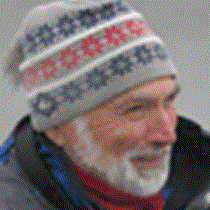Glacier Bay National Park
This morning the National Geographic Sea Bird became the first tour boat to enter Glacier Bay for the season. Our timing had advantages, like not passing any other boats or large ships the entire day, having wildlife that was often close to the water and easy to view and having a sense that the park was fresh from winter storms, cleansed by rain and repainted with the white of winter snow. We picked up our ranger, Marylou Blakeslee, and cultural interpreter, Alice Haldane, and headed into the park before most people were awake.
Our first stop was South Marble Island. Numerous birds were just arriving for the nesting season, including tufted puffins and hundreds of black-legged kittiwakes. More than 20 pairs of puffins were standing near the grassy carpets covering the tops of the rounded and sloped ledges, and it is here that they will tunnel into the soil to dig their nests. Most likely many of these birds will reuse older nests once they start nesting. Common murres were also standing in their upright position like penguins dressed formally with a white front and black jacket with tails. Different from formally dressed men, birds sport this finery to match the dark background when seen from above and appear light colored like the sky when seen from below to be camouflaged from both predators and the fish they pursue.
The very low-pitched growls of hundreds of northern sea lions were the first and last sounds we heard as we passed by the islands. Several very large males formed huge brown mounds piled upon the gray marble of the lower islands. The smaller animals were much more active, pointing their heads skyward or crawling across others. Brands on three of them showed they were born on Forester, White Sisters and Graves Islands. These are three of the four most important breeding areas for northern sea lions along the outer coast of Southeast Alaska. Between 1994 and 2004 biologists branded 3600 of these sea lions as pups to help better understand the population dynamics and determine how far individuals travel throughout their lives.
A short while later we spotted 15 mountain goats (or “Jan Wu” in Tlingit, the native language in this area) laying about or grazing a few hundred feet off the water on a series of grassy ledges. One nanny had a yearling kid. They were close enough for the photographers to hone their skills, practice what they’d learned over the last couple of days and record some impressive images. Later we stopped at Gloomy Knob, well known as a place to consistently find goats. There was a single animal only 25 feet above the water. The gray sky was helpful in avoiding the photographic problem of burning out the white goat on a dark cliff. More goats were higher up in a draw near the skyline. Another advantage of a trip early in the year is that snow is low enough to force the goats down closer to the water for improved viewing.
Just around the corner from the goats we found a brown bear walking along a gravel beach. It lumbered across a shallow creek, up a hillside, grazed a bit and then lay on its belly and went to sleep. Its head was pointed away from us, so it looked like a brown rock with a bare behind.
Margerie and Lamplugh Glaciers were bold, magnificent and a bit imposing. Only such gigantic structures could command such presence, aided by pristine blue faces and ragged pinnacle-covered tops. Ice toppled down the Margerie and made a great splash and wave that rocked us gently.
We pushed down the bay against a flood tide but made it back to Bartlett Cove for a walk after dinner. Darkness crowded in as we stepped off this great landscape and onto the ship for the night.




